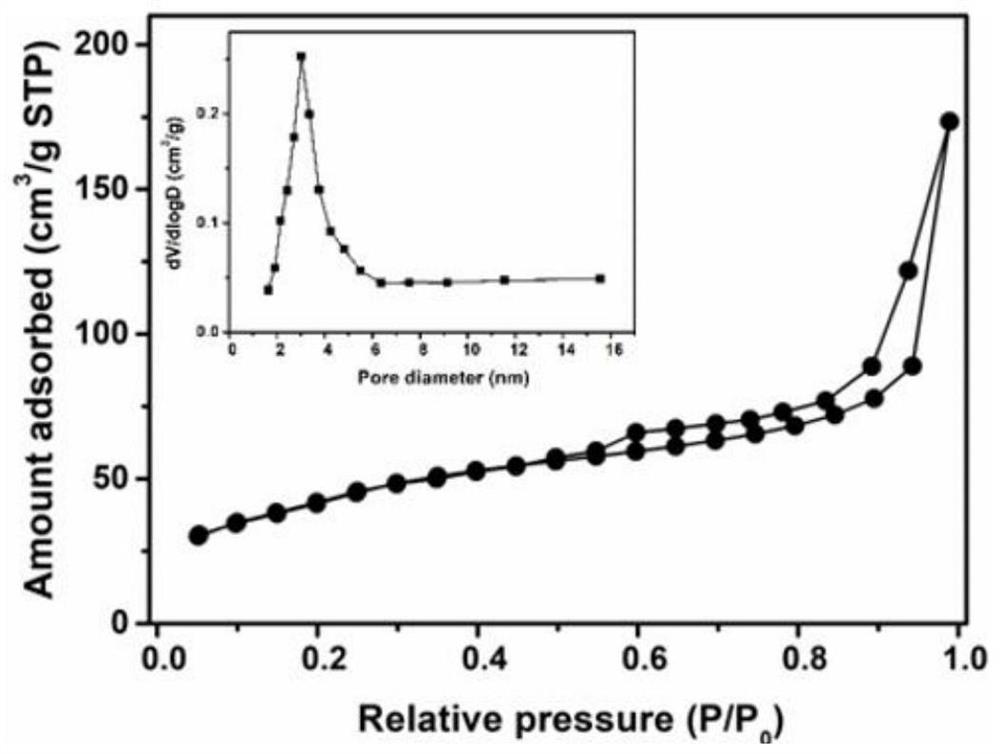Application of pH-responsive copper-based compound nanomaterial serving as disulfiram carrier in preparation of multi-level selective tumor treatment medicine
A technology of nanomaterials and copper compounds, applied in the field of nanobiomedicine, can solve the problems of low selectivity tumor toxicity and side effects
- Summary
- Abstract
- Description
- Claims
- Application Information
AI Technical Summary
Problems solved by technology
Method used
Image
Examples
Embodiment 1
[0046] 1. Preparation of copper-doped mesoporous silica nanoparticles
[0047] Copper chloride (0.034g) was first dissolved in a small amount of ethanol (1mL) and tetraethylorthosilicate (1mL), and ultrasonically mixed evenly. The solution was then slowly added dropwise to distilled water (50 mL) in which cetyltrimethylammonium bromide (0.18 g) and ammonium fluoride (0.3 g) were dissolved. After magnetic stirring for 4 h, the synthesized nanospheres were collected by centrifugation (8000 rpm, 10 min) and washed three times with distilled water and ethanol. The product was vacuum freeze-dried for 12 hours and sintered at 600° C. in air for 6 hours to obtain copper-doped mesoporous silica nanospheres. figure 1 It is the TEM image of Cu-MSNs, and the results show that the particle size distribution of the Cu-MSNs is uniform, and it is a spherical mesoporous structure, about 100nm; figure 2 is the EDS elemental distribution of Si, O, and Cu in Cu-MSNs, indicating that copper is...
Embodiment 2
[0050] Example 2, copper ion release of copper-doped mesoporous silica nanospheres at different pH:
[0051] Make 1mL copper ion concentration 2mg·mL -1 The Cu-MSNs solution was sealed in a dialysis bag (MCWO: 1000 Da), and immersed in centrifuge tubes filled with 20 mL buffer media of different pH (pH=7.4, 6.5 and 5.4). Shake the centrifuge tube at a speed of 200 rpm, and within a given interval, remove 1 mL of buffer solution and return 1 mL of fresh buffer solution, and analyze the copper ion concentration in the removed 1 mL buffer solution by ICP-AES. Figure 4 The copper ion release curves of Cu-MSNs under different acidic conditions show that Cu-MSNs exhibit a pH-dependent copper ion release ability. Under the acidic environment of pH 5.4, 25% can be released from Cu-MSNs within 12 hours. Cu 2+ , and only a very small amount (5%) of Cu in a neutral solution at pH 7.4 2+ let go.
Embodiment 3
[0052] Example 3. Drug release of copper-doped mesoporous silica nanospheres loaded with disulfiram at different pHs:
[0053] The 5mL mass concentration is 1.0mg·mL -1 The Cu-MSNs / DSF were placed in a dialysis bag (MW = 3500) and immersed in 100 mL of buffer medium, which was PBS with different pH (pH = 7.4, 6.5 and 5.4) containing 10% ethanol. At given time intervals, 2 mL of buffer was withdrawn and 2 mL of fresh buffer was returned, and the released DSF was determined by UV-vis absorption technique. Figure 5 The DSF release curves of Cu-MSNs / DSF under different acidic conditions show that the DSF release is still less than 20% after 24 hours of reaction in the simulated physiological environment, i.e. pH 7.4, while in the simulated tumor acid environment, i.e. pH 5. After 24 hours of reaction under the conditions of 4, the release of DSF far exceeded 60%. Image 6 It is the UV-Vis spectrum of Cu-MSNs and DSF under different acidic conditions. It can be seen that under t...
PUM
| Property | Measurement | Unit |
|---|---|---|
| particle size | aaaaa | aaaaa |
| pore size | aaaaa | aaaaa |
Abstract
Description
Claims
Application Information
 Login to View More
Login to View More - R&D
- Intellectual Property
- Life Sciences
- Materials
- Tech Scout
- Unparalleled Data Quality
- Higher Quality Content
- 60% Fewer Hallucinations
Browse by: Latest US Patents, China's latest patents, Technical Efficacy Thesaurus, Application Domain, Technology Topic, Popular Technical Reports.
© 2025 PatSnap. All rights reserved.Legal|Privacy policy|Modern Slavery Act Transparency Statement|Sitemap|About US| Contact US: help@patsnap.com



